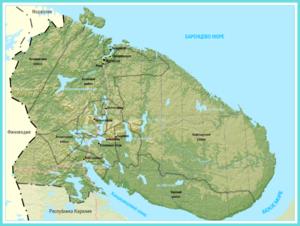The Kola Peninsula (from Northern Sami: Guoládat; Russian: Ко́льский полуо́стров, Kolsky poluostrov) is a peninsula in the far northwest of Russia. Constituting the bulk of the territory of Murmansk Oblast, it lies almost completely to the north of the Arctic Circle and is bordered by the Barents Sea in the north and the White Sea in the east and southeast. The city of Murmansk is the most populous human settlement on the peninsula, with a population of over 300,000 as of the 2010 Census.Despite the peninsula's northerly location, its proximity to the Gulf Stream leads to unusually high temperatures in winter, but also results in high winds due to the temperature variations between land and the Barents Sea. Summers are rather chilly, with the average July temperature of only +11 °C (52 °F). The peninsula is covered by taiga in the south and tundra in the north, where permafrost limits the growth of the trees resulting in landscape dominated by shrubs and grasses. The peninsula supports a small variety of mammals, and its rivers are an important habitat for the Atlantic salmon. The Kandalaksha Nature Reserve, established to protect the population of Common Eider, is located in the Kandalaksha Gulf.While the north of the peninsula was already settled in the 7th–5th millennium BCE, the rest of its territory remained uninhabited until the 3rd millennium BCE, when various peoples started to arrive from the south. However, by the 1st millennium CE only the Sami people remained. This changed in the 12th century, when Russian Pomors discovered the peninsula's game and fish riches. Soon after, the Pomors were followed by the tribute collectors from the Novgorod Republic, and the peninsula gradually became a part of the Novgorodian lands. No permanent human settlements, however, were established by the Novgorodians until the 15th century.The Novgorod Republic lost control of the peninsula to the Grand Duchy of Moscow in 1471, but the Russian migration did not stop. Several new settlements were established during the 16th century, and the Sami and Pomor people were forced into serfdom. In the second half of the 16th century, the peninsula became a subject of dispute between the Tsardom of Russia and the Kingdom of Denmark–Norway, which resulted in the strengthening of the Russian position. By the end of the 19th century, the indigenous Sami population had been mostly forced north by the Russians and the Komi and Nenets people who migrated here to escape a reindeer disease epidemics in their home lands. In 1916, Romanov-na-Murmane (now Murmansk) was founded and quickly became the largest city on the peninsula.The Soviet period saw a rapid increase of the population, although most of it remained confined to urbanized territories along the sea coast and the railroads. The Sami people were subject to forced collectivization, and overall the peninsula was heavily industrialized and militarized, largely due to its strategic position and the discovery of the vast apatite deposits in the 1920s. As a result, the ecology of the peninsula suffered major ecological damage, including contamination by military nuclear waste and nickel smelting.After the dissolution of the Soviet Union, the economy went into decline and the population quickly started to decrease. Between 1989 and 2002, Murmansk Oblast lost almost a quarter of its population; and almost 100,000 more between 2002 and 2010. Nevertheless, the economy rebounded somewhat in the first decade of the 2000s and the peninsula remains the most industrially developed and urbanized region in northern Russia.




Comment
0